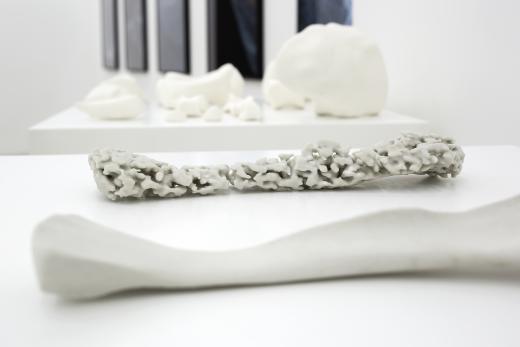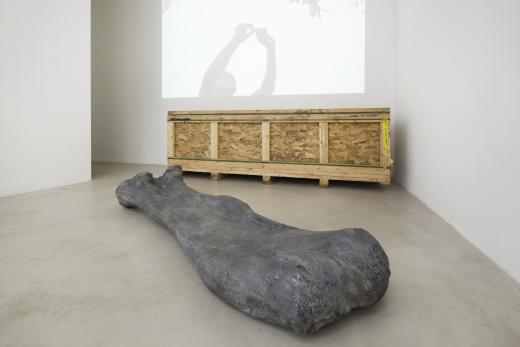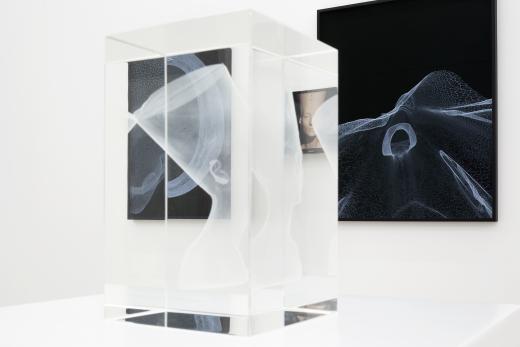Have you met... Nora Al-Badri & Nikolai Nelles
Have you met... Nora Al-Badri & Nikolai Nelles

The Berlin-based artists Nora Al-Badri and Nikolai Nelles have spent the last eight years working together in a multidisciplinary way that encompasses visual art, documentary filmmaking, and cultural activism. Their practice earned controversial reputation on the one side and support on the other for interfering in social infrastructures through performances that challenge institutions. The duo pursues a critical re-evaluation of actual cultural commons, the power of representation through material objects of other cultures, their digital image, as well as the concepts of heritage and identity politics.
We met the artist pair to find out more about their practice and the projects shown in the ongoing exhibition "Not a Single Bone“ at the NOME Gallery.
Let's start at the beginning. How did you two meet and decide to work together?
We started to collaborate almost as we met, somewhere between Berlin, Frankfurt, and Offenbach back in 2009.
Which topics or issues are you most interested in questioning and working through as artists?
We'd like to answer this more general here, you will find out what we mean by that by looking at and discussing our works. We are interested in unveiling and deconstructing power structures, which brings us to the topic of decolonization and democratization of institutions and, of course, the role of technology in all of that! We guess what's important is that, within our practice, we are not agitating about the matter of decolonization, rather activating the artifacts and trying to open new narratives as well as setting precedents. The dinosaur, for example, in the “Fossil Futures” project thereby serves as speculative material for renegotiating those ideas.
What are you showing in your current exhibition, "Not a Single Bone", at the NOME Gallery?
We are showing works from two of our projects, "The Other Nefertiti" from 2015 and "Fossil Futures" as the most recent work. Based on the fact that we found the data of the Brachiosaurus skeleton which is located in the Natural History Museum in Berlin (we can't reveal how we found it, though). Just like the museum tells the story, that German researchers found the skeletons in Tanzania over 100 years ago (see their description on the website, which is a fairly incomplete description and incorrect, because the locals knew and lived side by side with the fossils).

One piece, "How an AI imagines a dinosaur", deals with questions about cultural commons as well as questions deriving from the development of artificial intelligence concerning creativity and imagination, and colonial entanglements. The dinosaur data of the bones is the subject of exploration with an evolutionary algorithm: we asked a generative design AI to dream how dinosaurs would have evolved if they wouldn’t have gone extinct. The AI completes parts of the skeleton, since not one skeleton was found with 100% of the bones ever, the paleontologists always needed artists such as painters or sculptors to complete the skeletons for the museum display. For this specific skeleton – one of the biggest dinosaur skeletons ever found, the Brachiosaurs Brancai from Tanzania – around 30% of the Brachiosaurus skeleton parts were never found during the excavation. In the history of dinosaur depiction, being painted or erected in the museums is a lot of human creativity involved, which brought dinosaurs back to imaginary life. And they seem to be one of the most powerful icons in pop culture to attract people (hence they are used as centerpieces for natural history museums, but also in technology as default/model objects showing what technology is able to do). By this, we ask questions about human vs. artificial creativity as well as about the scientific truth about the authenticity of the incomplete dinosaur skeletons.
Then we have a large specimen, a two-meter replica from the femur of the Brachiosaurus based on the same data, and part of an installation with its transport box and a video work "Territories of Cultural Fracking".

In "The Other Nefertiti", we will be showing a video with some selected remixes which were created by the public in the aftermath of the data leak. They are amazing! And every day people are uploading more images of Nefertiti prints or digitally animated models. There are thousands, and this is definitely an important part of the piece itself which shows the power of the public domain. But we will be also showing other re-materializations of the data, such as wireframe prints and laser in glas. There is a fascination with data of objects because you can see details, which the object itself won't ever reveal.

Additionally, there are parts of our research accessible, inspiring interviews with amazing people and researchers like Adrienne Mayor (Stanford University), W.J.T. Mitchell (University of Chicago), Denny Gayton (Standing Rock), and Ciraj Rassool (University of Cape Town).
Could you explain the process of making your most recent work – "Fossil Futures" – from the initial idea to the final project exhibited at NOME?
It's obvious that our works bring us to research and stay a lot in the Global South, which to us seems more interesting and relevant anyways. For this project we went to undertake research in the beginning of this year in Tanzania and South Africa, funded by Haus der Kulturen der Welt. So here is some background and context on what led us to initiate the "Fossil Futures" project: more than 100 years after the gigantic systematic excavation of 250 tons of dinosaur bones in German-East Africa at a place known as Tendaguru, this place is still there, forgotten and overlooked, yet remarkably special. A hill in the midst of the bush, where to this day so many layers of history are in the ground and where the local community preserves unique knowledge about the environment and their history and social practices. The local narratives, as well as knowledge, never played a role in the colonial project or even today, where the bones are represented solely under a Western concept of natural science, decontextualized and deprived of their origins in the Natural History Museum in Berlin. At Tendaguru we found all the sediments of time, from a Heller (the coin of colonial currency), 3000 years old pottery, to fossilized creatures millions of years old. During our (re)search in Germany and Tanzania, we figured that neither most of the Tanzanians are aware of this heritage site, nor are the majority of the Germans aware of the fact that those bones are originally from Tanzania and about the colonial entanglement. It took quite some time to even just find the location of the place because in the closest city in southern Tanzania, Lindi, no one would know about Tendaguru and its past. This history is almost erased and just very close to the site, the village inhabitants can remember.
The site and the finds are well researched for 100 years from a natural science perspective. But what is blatant and symptomatic is that no one ever asked those people living around the site about their relation to the fossils. During our research, we learned about spiritual and healing practices carried out by the villagers until today by using the site and the fossils. In the past Tendaguru was a sacred place to the community where people would go when there were calamities to do rituals. We can't just present in Germany the knowledge that was entrusted to us, but our aim is to create value at the site and the community itself.
The local community is very aware of the fact that the German institutions as a continuation and institutionalization of colonialism are still profiting from the looted resources acquired under unjust conditions shortly after the infamous Maji-Maji war. The grandparents of the people of Miangala at Tendaguru were involved and exploited in the excavation process and passed their knowledge and accounts to their children and grandchildren. Today, the local community is longing for justice and space where the injustice of the past and presence can be articulated and discussed with a wider audience. One result of the research in the Tendaguru area on the topic of the fossils was that the local community of Miangala commissioned us to bring back the bones in an artistic way and to find alternative ways of bringing the locality to live again. We can talk about this later because this is what will happen in 2018.
What are you aiming to uncover with this project?
A lot of things! "Fossil Futures" is not centered around requests of restitution, rather on questions about the hierarchy of knowledge such as indigenous versus Western-centered scientific, and the dinosaur as a metaphor for excavation and land grabbing. These things are ironically happening today in the same region in Tanzania through a consortium of multinationals and the World Bank (project name is SAGCOT), which already received quite some criticism. This is what one could call colonial continuities. And this is in stark contrast to leaving the soil as it is and the sense that the earthly remains of past lifeforms should be respected by leaving them in place, which was evident in most Native cultures.
By manipulating and reproducing these fossils, which you can see in the exhibition with the help of artificial intelligence and leaked data, as well as with the classic tools of natural history museums, we question the fictions of authenticity told by Western institutions and seek to uncover alternative emancipatory narratives.
Somehow the Museum is the dinosaur here because frankly, museums and cultural institutions are power structures – they were constructed to show the power of the country, whereby possessing things from all over the world was like possessing the world in a quite literal way. You can sense this notion until today (think of the so-called Humboldtforum currently in the making) mixed with a great deal of inherent institutional self-preservation. Museums serve an ideological role by separating artifacts from their origins, depriving people of their historical memory, and presenting the history of the Others from a truly scientific standpoint.
After your 2015 project, "The Other Nefertiti", you became known as hacktivists to the wider public. What were some of the reactions your works provoked since then?
After we leaked the data on a public domain, there were uncountable downloads and, within weeks, thousands of remixes or images of 3D prints from all over the world appeared there. The beauty of the remix, the copy, and the participation this project sparked is an essential part of the work. Then we had very positive reactions from the open-source movement, but there were also lawyers citing our project as evidence for the copyfraud happening in public museums. Let's say that some reactions are polarizing. There are museums like the SMK Copenhagen which collaborate with us and try to learn from the Nefertiti Hack, and there are others, like the Berlin Natural History Museum, which refuses any cooperation.
What would you like to see as a direct result of your artist-activist work?
With our works and interventions we strive to change the reality and the dominant narrative, or – to be more precise – the economic reality, and not to be solely symbolic. With the Nefertiti it was the act to put the data on a public domain free for everyone and to tear up the monopoly of the Neues Museum, which earns more than 1 million EUR per year just with licensing, not to mention that you can actually buy a copy in the museum for 8.900 EUR. And the upcoming project "Fossil Futures" is actually a counter-landgrabbing. To us, dinosaurs are also a metaphor for the Western way of extracting all kinds of natural resources, including past lifeforms. This is in stark contrast to leaving the soil as it is and the sense that the earthly remains of past lifeforms should be respected by leaving them in place, which was evident in each Native culture we have a record of. With those interventions, we hope to contribute to a necessary collective imaginery where some of our societal challenges are re-negotiated. To refer to a famous quote from Fredric Jameson that comes up when talking about dinosaurs and actual extinction – we live in a time where it is easier to imagine the end of the world than the end of capitalism! That's where we are now and that's the closest we can get to a "direct result" from your question.
Could you tell us something about your upcoming project(s)?
This show will only be the kick-off for a variety of events on this issue in 2018. We were commissioned by the people of Tendaguru, and we call this undertaking "Fossil Futures", to initiate a re-centering, a reclaiming of territories, which are currently occupied by multinationals and the World Bank directly at Tendaguru and where cultural fracking took place through German museums. In cooperation with the regional government and affiliates from the University of Witwaterstrand Johannesburg, we plan to initiate a transformation of Tendaguru into what is called participatory forest reserve to activate the space in situ and overcome indigenization or a romanticized view of technology, immersiveness, and nature.
The museum in the Tanzanian bush is an investigative narration and re-imagining of a museum rather than an actual institution. Even though the locality and the topos play a crucial role with regards to re-centering in the postcolonial realm, our aim to use technology amidst nature is to anticipate possible non-anthropocentric futures as an experience to contribute to a collective imaginary through what we call technoheritage. Thus to create new platforms of (re)presentation of the subaltern instead of echoing the conventional yet vicious museum.
Where do you plan to show the two pieces from the exhibition at NOME next?
We are having a solo show at Aksioma Institute for Contemporary Art in Ljubiljana where we show "The Other Nefertiti" more in-depth between October 4 and November 3 (more info). End of October we will also be at the Influencers Festival in Barcelona, as well as a group exhibition curated by Gretta Louw with the title "Networking the Unseen" taking place at Villa Merkel from December 17 till March 4.
* * * * *
Nora Al-Badri & Nikolai Nelles — "Not a Single Bone"
September 9 — November 11, 2017
NOME / Glogauer str. 17 10999 Berlin
More info